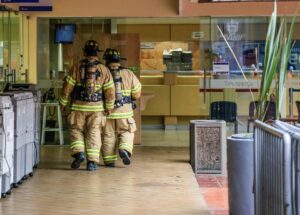
When discussing life safety solutions, fire suppression is likely one of the first things that comes to mind for many building owners. These systems can help protect occupants as well as buildings and equipment from fire damage. There are a few different types, and which one you choose for your building depends on many different factors.
Life Safety Solutions: What is Fire Suppression?
First off, what are fire suppression systems? These life safety solutions help extinguish or contain fires. In many cases, they can detect fires and automatically start methods to suppress fires. They’re different from fire alarms, which tell occupants to evacuate the building due to safety concerns. Building codes typically require Houston fire suppression systems in commercial buildings.
Types of Houston Fire Suppression Systems
Now, when you think of fire suppression, you probably think of sprinklers. However, these can cause pretty extensive water damage throughout your building. It’s important to know that other options are available!
Here are some other types of fire suppression:
- FM-200™
- Novec™ 1230
- Ecaro-25®
- Carbon Dioxide
- Water Mist
- Dry Chemical
Which type of fire suppression system you choose depends on many different factors, so it’s important to discuss your needs with fire and life safety pros.
Differences Between Fire Suppression Systems
FM-200 is a type of fire suppression, called a clean agent, that helps absorb heat to stop fires. This is safe for occupants and equipment and leaves no residue behind. It also doesn’t deplete ozone, but does have a higher global warming potential than many others because it contains hydrofluorocarbons.
Novec 1230 is another type of clean agent that reduces heat to help stop fires. This is also safe for humans and leaves no residue. While it may require more of the agent to suppress a fire, it’s one of the most environmentally friendly, with an atmospheric lifetime of only five days.
Ecaro-25 is a clean agent as well that absorbs heat, leaves no residue, and is safe for humans. It doesn’t deplete ozone, but similar to FM-200, uses hydrofluorocarbons, so it might have a larger global warming potential. With Ecaro-25, you may need less of the agent than FM-200.
Carbon dioxide systems disperse carbon dioxide to remove oxygen and suffocate fires. This leaves no residue. It’s usually used in unoccupied areas because it can pose a health risk in high concentrations, including asphyxiation. In addition, these systems need special life safety alarms to warn people it’s disbursing carbon dioxide.
Water mist uses small water droplets to help reduce heat and disrupt oxygen as it turns into steam. These are safe and nontoxic to humans, eco-friendly, and help minimize water damage compared to sprinklers. They require some clean up, but not nearly as much as sprinklers or dry chemical systems.
Dry chemical systems use chemical powder to help suffocate fires. These are typically used in industrial areas where combustible materials, flammable liquids, and live electrical equipment may be present, such as paint booths and chemical storage areas. They can be recharged multiple times, but do require cleanup afterwards.
Cutting-Edge Life Safety Solutions and Protection Technologies from Wilson Fire Equipment
When you need to protect your facility from fires, life safety issues, and security vulnerabilities, choose our experts at Wilson Fire Equipment. We’ve been helping protect facilities since 1916 and remain a family owned and operated organization to this day. Our team has the experience and knowledge you need for designing the right fire suppression systems for your needs. We also provide life safety and security systems monitoring in Houston for your peace of mind. Call us now at (713) 896-4747 for a free quote for system installation or service!
